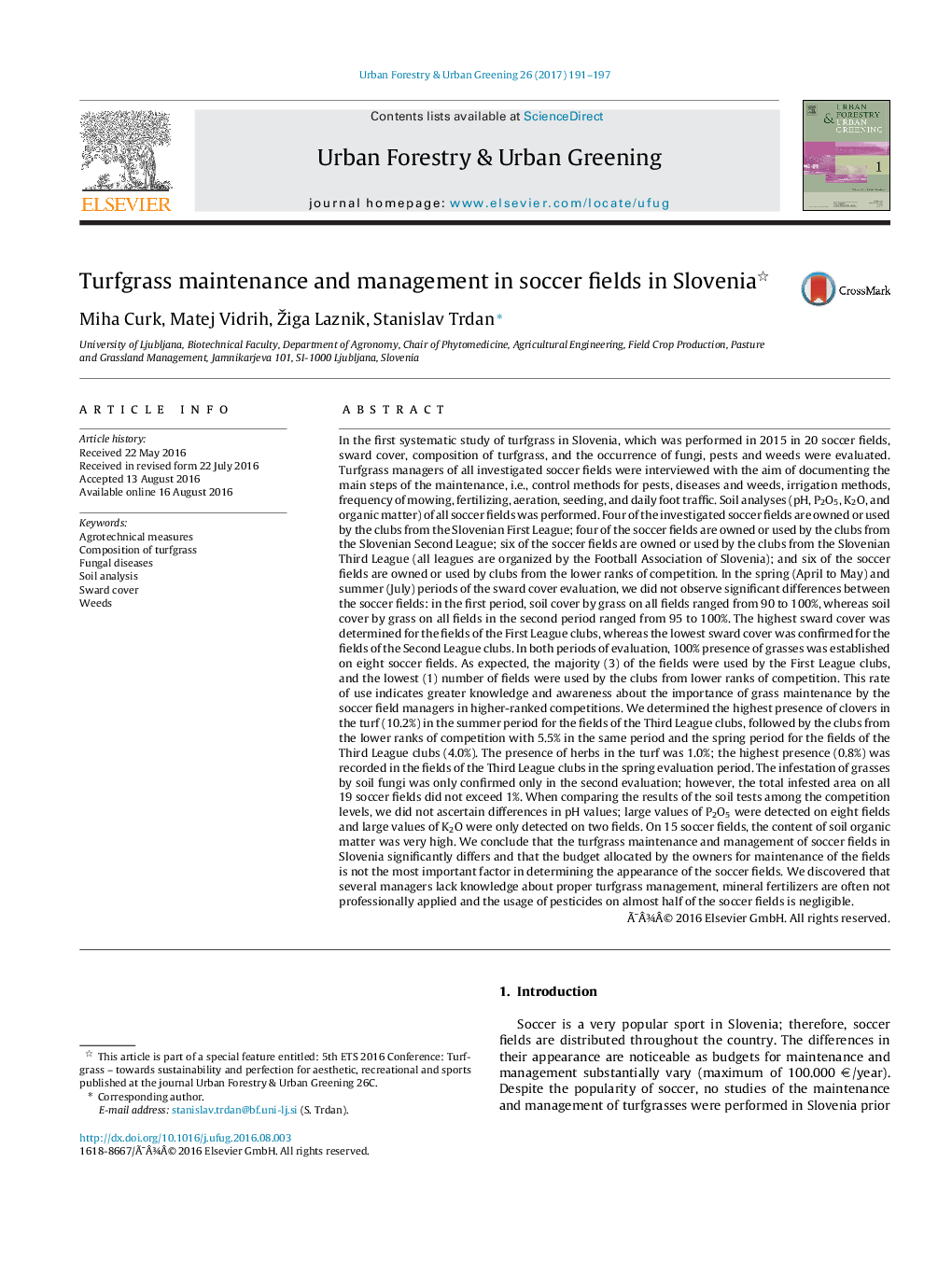| کد مقاله | کد نشریه | سال انتشار | مقاله انگلیسی | نسخه تمام متن |
|---|---|---|---|---|
| 6461804 | 1421864 | 2017 | 7 صفحه PDF | دانلود رایگان |
- The results of the first systematic study on (20) Slovenian soccer fields are presented.
- In the spring and summer periods of sward cover evaluations no significant differences between the soccer fields were established.
- The infestation of turfgrasses by fungal diseases was only confirmed in July; however, the total infested area on 19 soccer fields did not exceed 1%.
- The budget allocated by the owners for maintenance of the fields is not the most important factor in determining the appearance of the soccer fields.
In the first systematic study of turfgrass in Slovenia, which was performed in 2015 in 20 soccer fields, sward cover, composition of turfgrass, and the occurrence of fungi, pests and weeds were evaluated. Turfgrass managers of all investigated soccer fields were interviewed with the aim of documenting the main steps of the maintenance, i.e., control methods for pests, diseases and weeds, irrigation methods, frequency of mowing, fertilizing, aeration, seeding, and daily foot traffic. Soil analyses (pH, P2O5, K2O, and organic matter) of all soccer fields was performed. Four of the investigated soccer fields are owned or used by the clubs from the Slovenian First League; four of the soccer fields are owned or used by the clubs from the Slovenian Second League; six of the soccer fields are owned or used by the clubs from the Slovenian Third League (all leagues are organized by the Football Association of Slovenia); and six of the soccer fields are owned or used by clubs from the lower ranks of competition. In the spring (April to May) and summer (July) periods of the sward cover evaluation, we did not observe significant differences between the soccer fields: in the first period, soil cover by grass on all fields ranged from 90 to 100%, whereas soil cover by grass on all fields in the second period ranged from 95 to 100%. The highest sward cover was determined for the fields of the First League clubs, whereas the lowest sward cover was confirmed for the fields of the Second League clubs. In both periods of evaluation, 100% presence of grasses was established on eight soccer fields. As expected, the majority (3) of the fields were used by the First League clubs, and the lowest (1) number of fields were used by the clubs from lower ranks of competition. This rate of use indicates greater knowledge and awareness about the importance of grass maintenance by the soccer field managers in higher-ranked competitions. We determined the highest presence of clovers in the turf (10.2%) in the summer period for the fields of the Third League clubs, followed by the clubs from the lower ranks of competition with 5.5% in the same period and the spring period for the fields of the Third League clubs (4.0%). The presence of herbs in the turf was 1.0%; the highest presence (0.8%) was recorded in the fields of the Third League clubs in the spring evaluation period. The infestation of grasses by soil fungi was only confirmed only in the second evaluation; however, the total infested area on all 19 soccer fields did not exceed 1%. When comparing the results of the soil tests among the competition levels, we did not ascertain differences in pH values; large values of P2O5 were detected on eight fields and large values of K2O were only detected on two fields. On 15 soccer fields, the content of soil organic matter was very high. We conclude that the turfgrass maintenance and management of soccer fields in Slovenia significantly differs and that the budget allocated by the owners for maintenance of the fields is not the most important factor in determining the appearance of the soccer fields. We discovered that several managers lack knowledge about proper turfgrass management, mineral fertilizers are often not professionally applied and the usage of pesticides on almost half of the soccer fields is negligible.
Journal: Urban Forestry & Urban Greening - Volume 26, August 2017, Pages 191-197
